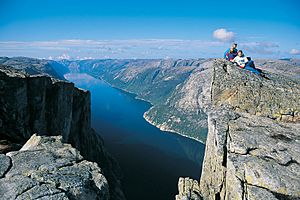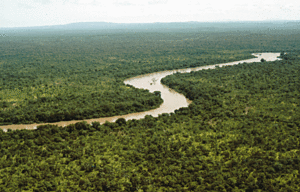Body of water facts for kids
A body of water is simply any natural collection of water found on Earth's surface. It can be a huge ocean, a calm lake, or a flowing river. These water bodies are super important for life on our planet. They provide homes for countless plants and animals. They also play a big role in the weather and climate of different regions.
Contents
What is a Body of Water?
A body of water is any place where water collects. This includes everything from a tiny puddle after it rains to the massive Pacific Ocean. Some bodies of water are still, like ponds or lakes. Others are always moving, like rivers and streams. The water can be fresh, like in a lake, or salty, like in the ocean.
Types of Water Bodies
There are many different kinds of water bodies around the world. Each type has its own special features. They are all important parts of Earth's water cycle.
Oceans and Seas
Oceans are the biggest bodies of water on Earth. They are huge areas of saltwater that cover about 71% of our planet's surface. There are five main oceans: the Pacific, Atlantic, Indian, Southern (Antarctic), and Arctic Oceans.
Seas are smaller parts of oceans. They are often partly enclosed by land. Examples include the Mediterranean Sea and the Caribbean Sea. Both oceans and seas are home to an incredible variety of marine life. This includes tiny plankton, huge whales, and colorful coral reefs.
Rivers and Streams
Rivers are natural flowing waterways. They usually flow towards an ocean, sea, lake, or another river. Rivers start from higher ground, like mountains or hills. They flow downhill due to gravity. As they flow, rivers collect water from smaller streams. These smaller streams are called tributaries.
Streams are smaller versions of rivers. They are narrow channels of flowing water. Rivers and streams are vital for freshwater supply. They also provide habitats for many fish and other animals. People often use rivers for transportation, fishing, and recreation.
Lakes and Ponds
Lakes are large bodies of still water. They are completely surrounded by land. Most lakes contain freshwater. However, some, like the Great Salt Lake in the United States, are salty. Lakes can form in different ways. Some form in volcano craters. Others form when glaciers carve out depressions in the land.
Ponds are smaller than lakes. They are also bodies of still water surrounded by land. Ponds are often shallower than lakes. This means sunlight can reach the bottom. This allows many plants to grow all the way across the pond. Lakes and ponds are important for local ecosystems. They support many types of plants and animals.
Other Water Bodies
- Glaciers and Ice Caps: These are huge masses of ice. They are formed from compacted snow over many years. Glaciers move very slowly. They are the largest freshwater reserves on Earth.
- Wetlands: These are areas where water covers the soil. This happens all the time or for long periods. Examples include swamps, marshes, and bogs. Wetlands are important for filtering water. They also provide homes for unique wildlife.
- Estuaries: These are places where a river meets the sea. Here, freshwater mixes with saltwater. Estuaries are very rich in nutrients. They are important nurseries for many fish and shellfish.
- Canals: These are artificial waterways built by people. They are used for irrigation, drainage, or navigation. The Panama Canal is a famous example. It connects the Atlantic and Pacific Oceans.
- Reservoirs: These are artificial lakes. They are usually created by building a dam across a river. Reservoirs store water for drinking, hydroelectric power, and irrigation.
Importance of Water Bodies
Water bodies are essential for life on Earth.
- Habitat: They provide homes for countless species of plants and animals.
- Water Supply: Rivers, lakes, and reservoirs are major sources of drinking water for humans.
- Climate Regulation: Oceans help regulate Earth's climate. They absorb heat and carbon dioxide.
- Transportation: Rivers and oceans have been used for travel and trade for thousands of years.
- Recreation: Many people enjoy activities like swimming, boating, and fishing in water bodies.
Protecting our water bodies is very important. This helps keep our planet healthy for everyone.
Images for kids
-
The Aubach, a watercourse in Germany
-
The Canal Grande in Venice, one of the major water-traffic corridors in the city. View from the Accademia bridge.
-
A tide pool in Santa Cruz, California with sea anemones and sea stars
See also
 In Spanish: Cuerpo de agua para niños
In Spanish: Cuerpo de agua para niños








